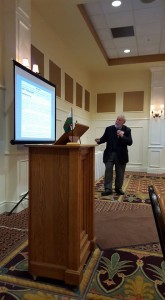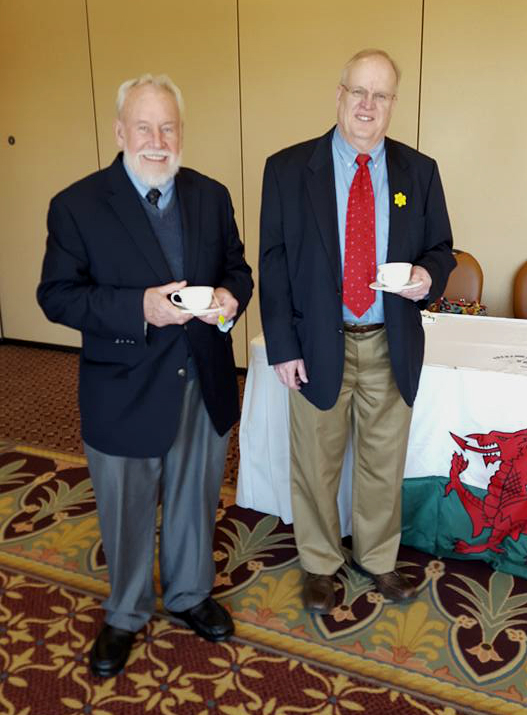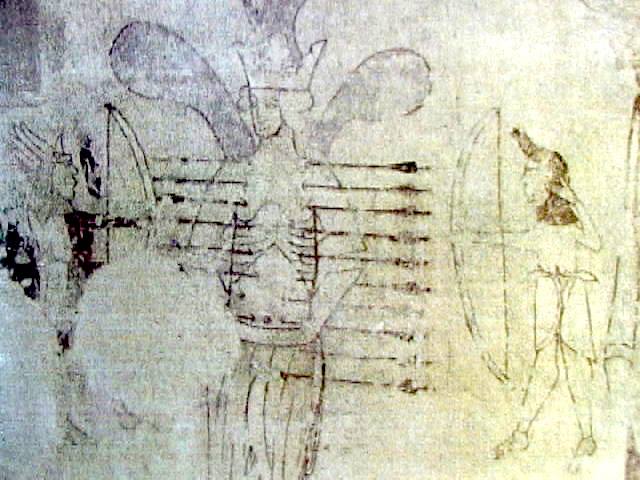Dr. Lee Pennington reveals true history of King Arthur
It was pure destiny and a cosmic event that Prince Madoc – brother of legendary King Arthur II, both sons of Welsh King Meurig – to wander the Atlantic Ocean for a decade leaving Wales A.D. 562 for the first time.
The head of the British naval fleet, Prince Madoc, became disoriented as what historians believe was a comet or other astronomical object slammed into earth near Britain with the force of 100 nuclear bombs, Arthur historian, Lee Pennington, Ph.D., explained.

Lee Pennington, Ph.D., speaks during a presentation on King Arthur’s journey to America March 26 at the Irem Temple Country Club, Dallas.
The naval commander, wandering the Atlantic circa sixth century, by chance came across what he described as a lush, green land.
When he finally returned to Wales and his brother, King Arthur of round table fame, 10 years after getting lost, he excitedly recounted his discovery of America.
Dr. Pennington brought these histories, long-criticized by skeptics, to life when he spoke March 26, 2016, at the Irem Temple Country Club. His talk, and an accompanying buffet lunch, were sponsored by The Welsh Cultural Endeavor of Northeastern Pennsylvania.
“I was delighted with the reaction,” Dr. Pennington said about his reception. “I don’t always get that with this story.”
Whether King Arthur traveled to America 900 years before Christopher Columbus or whether he existed at all, is the source of great controversy. And as one of the world’s leading experts on King Arthur’s life and journeys, Dr. Pennington is no stranger to criticism for his findings.
Dr. Pennington disavowed the notion that a non-existent, unrecorded Madoc who is an invented son of Prince Owen Gwynedd arrives here around A.D. 1175.
King Arthur traveled to what is now the United States, and he died here, Dr. Pennington said.

Dr. Lee Pennington, left, and The Welsh Cultural Endeavor of Northeastern Pennsylvania President George Horwatt pose for a photo during an event March 26 at the Irem Temple Country Club, Dallas.
He showed images of ancient murals that depict native Indians attacking a king, whose arms are spread-eagle, with arrows. Historical documents reveal King Arthur was mummified, wrapped in deer skin and returned to Wales where he lays to this day.
Widely accepted translations of “The Stanzas of the Grave,” an ancient poem describing the burial places of British kings, say Arthur’s grave is “concealed forever.” However, Dr. Pennington argues the translation distorts the original manuscript, and King Arthur’s grave, to the exact spot, is described in the texts. Dr. Pennington’s collaborating experts, Alan Wilson and Baram Blackett in England, offer that at least 10 clear records combine to tell of his body being returned to Wales following a great funeral.
“It actually says the grave of Arthur is in a high, windy place,” Dr. Pennington said, going on to explain the name of the field is Mynydd y Gaer meaning fortress mountain, which is long in range.
Dr. Pennington spoke and answered questions for nearly four hours before an engaged and enthusiastic audience on the true history of Welsh King Arthur as well as efforts by other historians to stamp it out. A good number of those attending were not actually Welsh, but followed their curiosity and keen interest in the history of King Arthur.
Dr. Pennington’s presentation is part of a greater effort by The Welsh Cultural Endeavor to introduce our region, which is well-stocked with Welsh descendants, to this, our exciting history, in hopes that we might preserve it and pass it on for generations to come.
Keep watch for more important events and programs to be announced by The Welsh Cultural Endeavor.
Leave a Reply
You must be logged in to post a comment.




